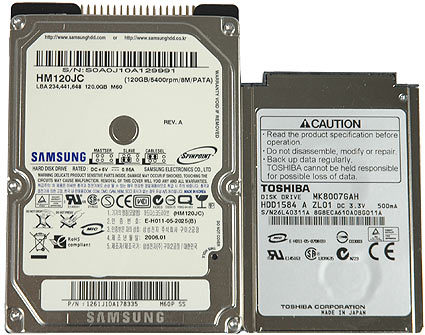1.8" Hard Drives: Small is Beautiful
Will 1.8" Hard Drives Do The Job?
There's a saying that "big is beautiful", but when it comes to PC storage, big is out. A look at the past 15 years reveals the obvious trend: hard drives are shrinking in size. For many years, 5.25" drives were the standard, but they were replaced by 3.5" units. The advantages of reduced platter diameters are quicker access time and faster rotation speed, both of which are pillars for performance. 2.5" drives have been the standard for portable equipment for several years, and have also been used for stationary hardware of late, but the 1.8" form factor is now also picking up steam.
Will these models completely replace 3.5" drives at some point? We do not think so. Although drive downsizing will continue, it has completely different reasons today. An increasing number of servers uses 2.5" enterprise-class drives, because more of these fit into the space than 3.5" drives. The higher drive count is referred to as drive density, and improving it helps to increase performance. However, notebook computers and derivatives are the more substantial growth area - whether it is tablet PCs, ultra-portable notebooks or ultra mobile PCs (UMPCs), all of them depend on the ability to store ever-increasing amounts of data as compactly as possible.
Today, 2.5" hard drives dominate the portable PC space, and thanks to a variety of rotation speeds, the available performance spectrum is satisfactory. Yet even at 3.5 ounces, a 2.5" drive is too big and too heavy for the smallest computers, where size and weight matter more than any other factors. To meet this need, manufacturers came up with the 1.8" form factor for ultra-small PCs, and even 1" and 0.85" drives for PDAs, digital cameras and similar devices. Also bear in mind that the market for car PC applications will also multiply in the coming years, which will further increase the growth potential for small hard drives.
We deliberately characterized the performance spectrum of 2.5" hard drives as "satisfactory", and no more. This is because most 2.5" drives still work at lower rotation speeds than current 3.5" models, which is one reason for notebooks still being noticeably slower than most desktop PCs. Booting Windows, or starting games or applications takes longer on 2.5" drives, especially if they spin slowly. Also, the more applications you run in parallel, the more noticeable this performance deficit becomes. Services such as the desktop search from Google or Microsoft, or anti-virus programs, can quickly put the brakes on a low-performance hard drive.
Toshiba is clearly dominating the 1.8" drive segment today, but Hitachi has been competing in this area for a while as well. We compared the current models from both manufacturers.
Join our discussion on this topic
Get Tom's Hardware's best news and in-depth reviews, straight to your inbox.
Current page: Will 1.8" Hard Drives Do The Job?
Next Page PMR: Perpendicular Magnetic Recording
Patrick Schmid was the editor-in-chief for Tom's Hardware from 2005 to 2006. He wrote numerous articles on a wide range of hardware topics, including storage, CPUs, and system builds.
